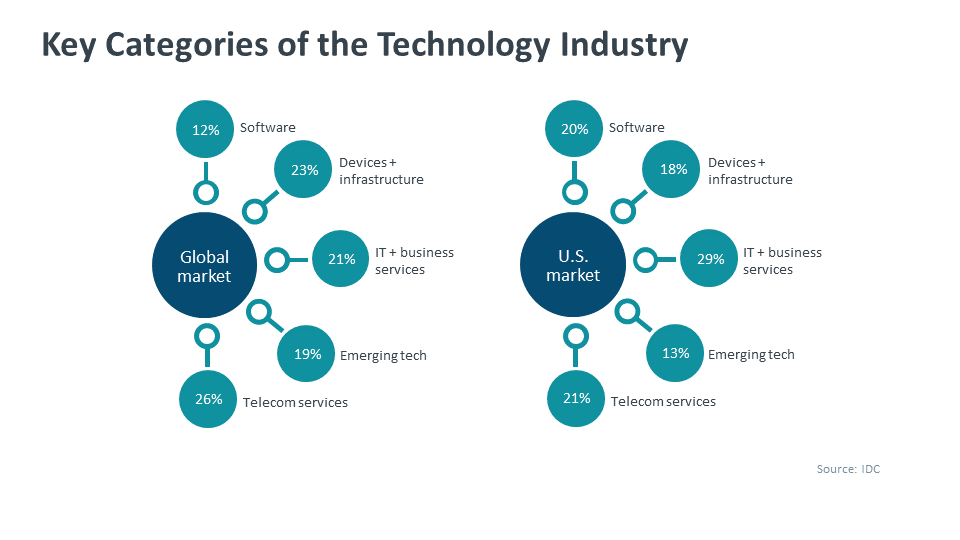What’s in 2025: The Technology Landscape Of The Future
By 2025, digital operations have become foundational for businesses across all sectors. The pandemic-driven shift to remote and hybrid work models cemented the necessity for organizations to adopt robust digital frameworks that support flexibility, resilience, and innovative approaches to problem-solving. Many companies have embraced cloud computing for business, automation, and AI-driven analytics to enhance operational efficiency and responsiveness to market changes within the technology landscape. As we look forward to 2025, several key trends and developments are shaping the technology landscape.

Market Growth and Investment Trends
According to a report by Statista, the global information technology market is projected to surpass $6 trillion by 2025, reflecting a compound annual growth rate (CAGR) of approximately 6% from 2021 onward. This growth is driven by strong demand in areas such as cybersecurity, emerging technologies, and AI technologies, underscoring the critical role of digital transformation cloud solutions within the technology landscape in maintaining competitive advantage.
6 Key Trends Shaping the Technology Landscape
Several pivotal trends are defining the technology landscape in 2025:
1. Artificial Intelligence and Machine Learning
AI and machine learning have continued to dominate technological advancements, permeating nearly every industry. Businesses are leveraging these technologies not only to improve decision-making but also to enhance customer experiences and streamline operations. In particular, machine learning development is enabling organizations to analyze vast amounts of data more effectively. From predictive analytics in retail to AI-driven diagnostics in healthcare, AI’s role across various sectors is set to grow exponentially. According to McKinsey, around 70% of organizations now report using AI in their operations, up from 50% in 2020. Furthermore, advancements in natural language processing (NLP) have facilitated more intuitive interactions between humans and machines, fundamentally altering customer service, sales, and content creation within the technology landscape.
2. Cybersecurity and Data Privacy
With the rise in cyber threats, the focus on cybersecurity has never been more critical. As we look to the cybersecurity future, enterprises are increasingly adopting zero-trust frameworks and investing in comprehensive security measures to protect sensitive data and maintain customer trust. According to Cybersecurity Ventures, global spending on cybersecurity is projected to exceed $1 trillion from 2017 to 2021. Regulatory frameworks surrounding data privacy, including GDPR and CCPA, demand greater transparency and accountability, further prompting organizations to prioritize data protection as a core business objective in the evolving technology landscape. The ramifications of data breaches continue to lead to significant financial and reputational damage, reinforcing the need for robust cybersecurity strategies.
3. Remote Work and Collaboration Tools
The normalization of remote work environments has led to the proliferation of collaboration tools designed to enhance productivity and connectivity. By 2025, companies are utilizing advanced platforms that seamlessly integrate project management, communication, and productivity tools. This shift has fostered a culture of collaboration regardless of physical location. In addition, the rise of augmented reality (AR) and virtual reality (VR) technologies is likely to transform remote collaboration, providing immersive experiences that bridge the gap between in-person and virtual interactions within the technology landscape.

4. Sustainable Technology Practices
As awareness of environmental issues grows, sustainability has become a critical consideration in technology development. Organizations are adopting green computing practices, such as energy-efficient data centers and eco-friendly hardware, as part of their commitment to corporate social responsibility (CSR). Moreover, innovations in energy-efficient technologies, such as AI-driven energy management systems and renewable energy integration, are helping businesses reduce their carbon footprints while optimizing resource usage within the technology landscape.
5. Edge Computing and IoT
The rise and the importance of Internet of Things (IoT) devices has transformed how businesses collect and analyze data. Edge computing has emerged as a vital solution for processing data closer to the source, minimizing latency and maximizing efficiency. By 2025, the integration of edge computing with 5G technology will enable real-time data processing across numerous applications, from smart cities to industrial automation. This technological convergence allows for more responsive systems and has broad implications for industries such as transportation, healthcare, and manufacturing in the evolving technology landscape.
6. Blockchain and Decentralized Solutions
Blockchain technology‘s adoption has surged beyond cryptocurrency. By 2025, we see an increasing number of businesses using blockchain for supply chain transparency, secure transactions, and decentralized finance (DeFi) applications. These innovations not only enhance security and trust among stakeholders but also streamline operations and reduce costs by eliminating intermediaries in various processes. Smart contracts are increasingly being used to automate and enforce agreements, transforming traditional business processes as part of the broader technology landscape.
Budgeting and Resource Allocation
Heading into 2025, businesses are re-evaluating their IT infrastructure management budgets to align with evolving priorities. A significant percentage of organizations now allocate a larger share of their budgets to technology investments, recognizing that technology is not just an operational backbone but a central driver of strategic growth and competitive advantage within the technology landscape. A recent survey by Gartner revealed that organizations plan to allocate 50% of their technology budgets to digital transformation initiatives by 2025. Many companies are focusing on IT budgets that prioritize innovation and digital transformation, anticipating continued shifts in market dynamics driven by technological advancements.
The allocation of budgets toward emerging technologies is creating new opportunities for investment in R&D. Firms are directing funds toward AI, data analytics, and sustainable technology initiatives, acknowledging these areas as crucial to ensuring long-term sustainability and growth within the technology landscape. Moreover, companies are seeking to harness the power of public-private partnerships and government initiatives aimed at fostering innovation and technology adoption, particularly in sectors like healthcare and education.
The Human Element: Workforce Transformation
The tech workforce has undergone significant changes since 2020. By 2025, organizations are increasingly focused on building diverse teams infused with specialized skills across core domains such as AI, cybersecurity, software development, and data science. Workforce development strategies are evolving to prioritize lifelong learning, with companies investing in upskilling and reskilling programs to ensure employees remain competitive in an ever-evolving job landscape.
Moreover, the emphasis on soft skills such as communication, adaptability, and emotional intelligence is rising as teams become more collaborative and less hierarchical. Organizations recognize that a psychologically safe work environment is essential for creativity and innovation, thus fostering a culture where diverse perspectives are welcomed, and continuous feedback is encouraged within the technology landscape.
Final Thoughts
As we look ahead to 2025, the technological horizon is rich with opportunities and challenges. The rapid pace of innovation, driven by the convergence of AI, IoT, blockchain technology, and sustainable practices, underscores the need for organizations to adapt and evolve within the technology landscape. Embracing these advancements will be essential for businesses striving to remain competitive and thrive in an increasingly digital world.
To navigate this dynamic landscape and harness the full potential of technology, partnering with forward-thinking technology consulting services and software development companies will be crucial. Organizations must prioritize digital transformation, invest in talent development, and embrace sustainable practices to not only meet the demands of their customers but also contribute positively to society.
In conclusion, the technology landscape of 2025 presents a unique opportunity for companies to redefine their operations, enhance their customer experiences, and implement sustainable practices that will shape industries for years to come. Staying ahead in this fast-paced environment will require agility, foresight, and a commitment to leveraging technology as a cornerstone for growth.
FAQ
1. What are the most important technology trends in 2025?
Key trends include AI/ML, cybersecurity, edge computing, blockchain, remote work tools, and sustainability-driven innovations like green computing.
2. How can businesses prepare for the 2025 tech landscape?
Businesses should invest in cloud-based infrastructure, upskill teams in AI and cybersecurity, embrace digital transformation, and partner with tech consultants.
3. Why is cybersecurity more important in the future?
With rising cyber threats and data regulations like GDPR/CCPA, businesses must implement zero-trust frameworks, encrypted systems, and real-time monitoring.
4. How does edge computing change business operations?
Edge computing reduces latency by processing data closer to the source, enabling real-time decisions in manufacturing, healthcare, and smart cities.
5. Will blockchain become mainstream by 2025?
Yes. Beyond cryptocurrencies, blockchain is being adopted in logistics, voting, and healthcare for transparency, decentralization, and smart contracts.
Savvycom – Your Trusted Tech Partner!
If you are looking for a partner with those critical capabilities in software development services to help you leverage your digital initiatives, please contact us. As a technology consultant with 15 years of experience, we are committed to not only providing the best social app ideas to help your business grow but also turning those initiatives into a complete product.
Savvycom is what you need. Contact us now for more consultation:
- Phone: +84 24 3202 9222
- Hotline: +84 352 287 866 (VN)
- Email: [email protected]


